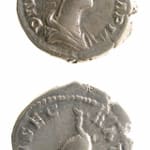Silver Denarius of Empress Faustina Junior Issued Posthumously, 176 CE - 180 CE
Silver
C.5110
Obverse: DIVA FAVSTINA PIA; Draped Bust of the Empress Facing Righ Reverse: CONSECRATIO; Peacock Standing Towards the Righ Annia Galeria Faustina was born about 127 A.D., daughter of Emperor Antoninus...
Obverse: DIVA FAVSTINA PIA; Draped Bust of the Empress Facing Righ
Reverse: CONSECRATIO; Peacock Standing Towards the Righ
Annia Galeria Faustina was born about 127 A.D., daughter of Emperor Antoninus Pius and Faustina the Elder. Hadian engaged her to Lucius Verus; but when Pius became Augustus on July 10, 138, he broke off the union and engaged her to Marcus Aurelius. Due to her youthful age, the wedding was postponed several years until 145. Her first of perhaps thirteen children (including future Emperor Commodus) was born in November of 147, when she received the title of Augusta. She accompanied Aurelius on some campaigns and trips, and was with him when she died at Halala in Cappadocia in late 175. She was soon deified, and Halala was re-founded as Faustinopolis.
How many hands have touched a coin in your pocket or purse? What eras and lands have the coin traversed on its journey into our possession? As we reach into our pockets to pull out some change, we rarely hesitate to think of who might have touched the coin before us, or where the coin will venture to after it leaves our hands. More than money, coins are a symbol of the state that struck them, of a specific time and location, whether contemporary currencies or artifacts of a long forgotten empire. This stunning hand-struck coin reveals an expertise of craftsmanship and intricate sculptural detail that is often lacking in contemporary machine-made currencies. This ancient coin is a memorial to a powerful woman passed from the hands of civilization to civilization, from generation to generation that still appears as vibrant today as the day it was struck.
Reverse: CONSECRATIO; Peacock Standing Towards the Righ
Annia Galeria Faustina was born about 127 A.D., daughter of Emperor Antoninus Pius and Faustina the Elder. Hadian engaged her to Lucius Verus; but when Pius became Augustus on July 10, 138, he broke off the union and engaged her to Marcus Aurelius. Due to her youthful age, the wedding was postponed several years until 145. Her first of perhaps thirteen children (including future Emperor Commodus) was born in November of 147, when she received the title of Augusta. She accompanied Aurelius on some campaigns and trips, and was with him when she died at Halala in Cappadocia in late 175. She was soon deified, and Halala was re-founded as Faustinopolis.
How many hands have touched a coin in your pocket or purse? What eras and lands have the coin traversed on its journey into our possession? As we reach into our pockets to pull out some change, we rarely hesitate to think of who might have touched the coin before us, or where the coin will venture to after it leaves our hands. More than money, coins are a symbol of the state that struck them, of a specific time and location, whether contemporary currencies or artifacts of a long forgotten empire. This stunning hand-struck coin reveals an expertise of craftsmanship and intricate sculptural detail that is often lacking in contemporary machine-made currencies. This ancient coin is a memorial to a powerful woman passed from the hands of civilization to civilization, from generation to generation that still appears as vibrant today as the day it was struck.



